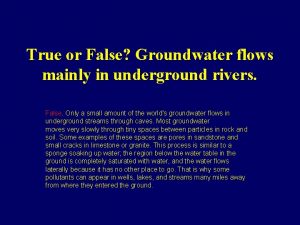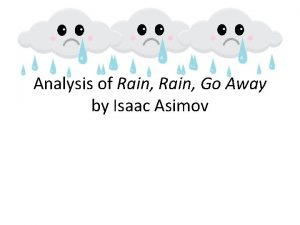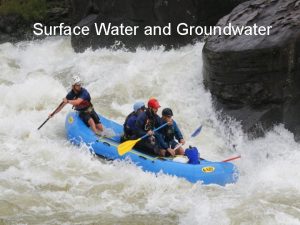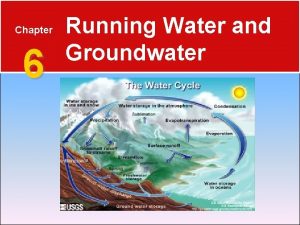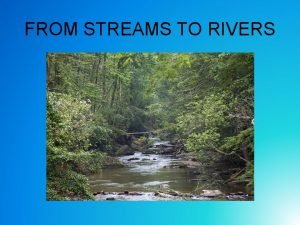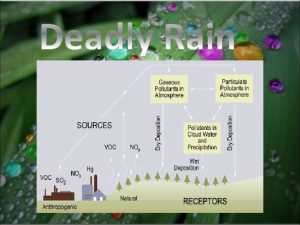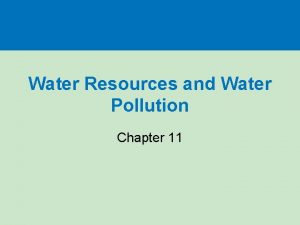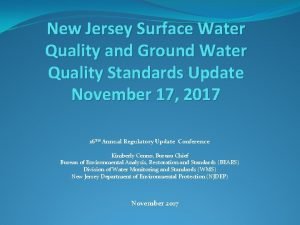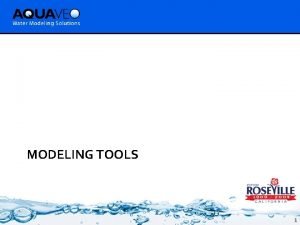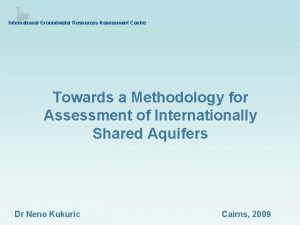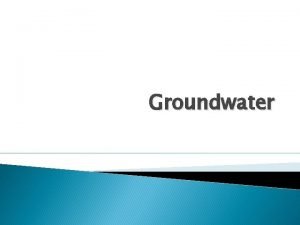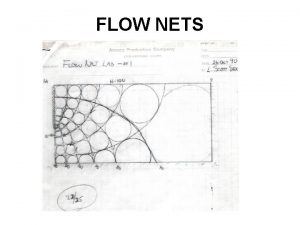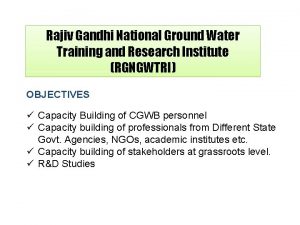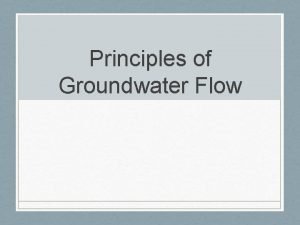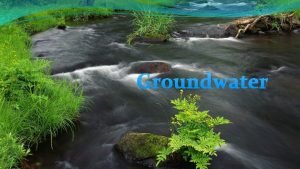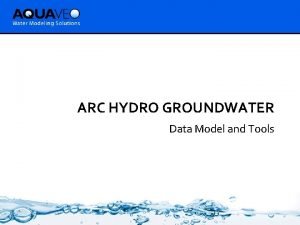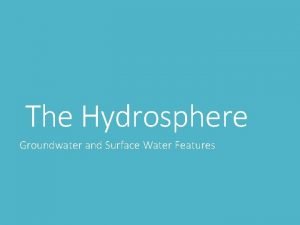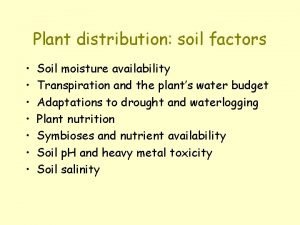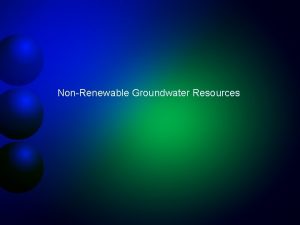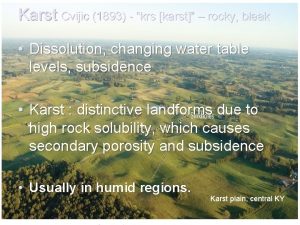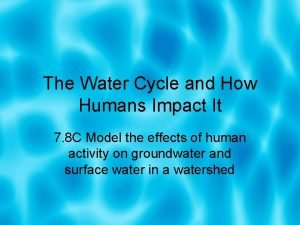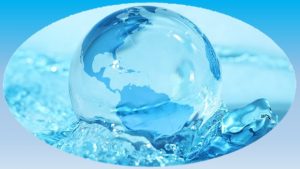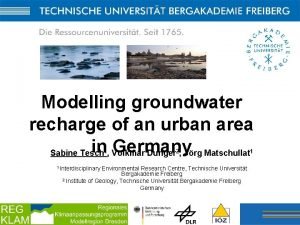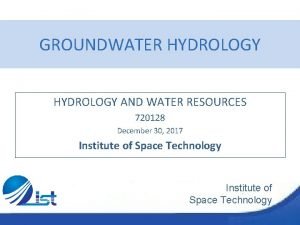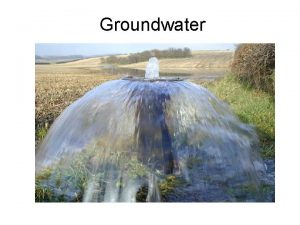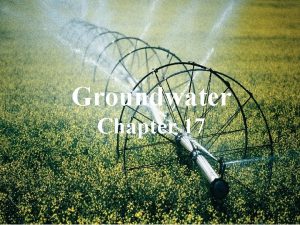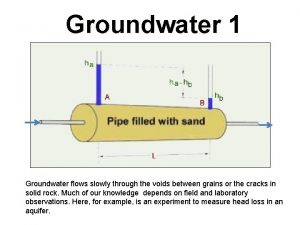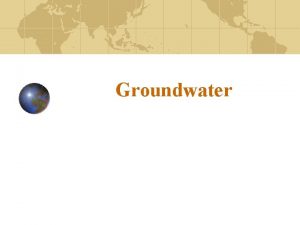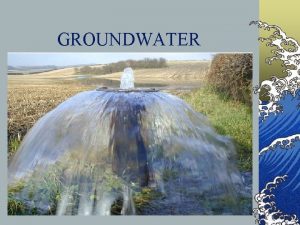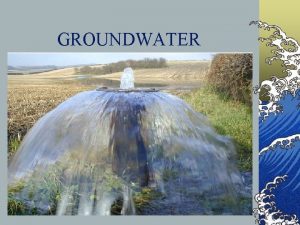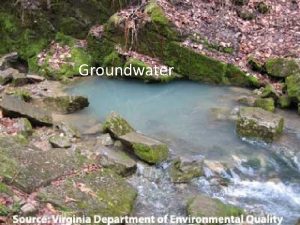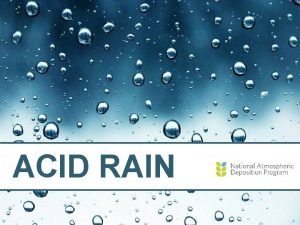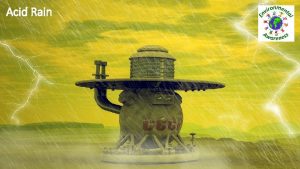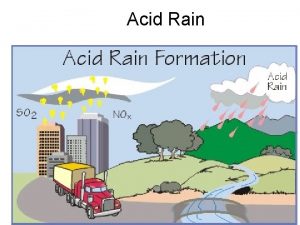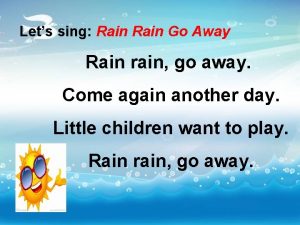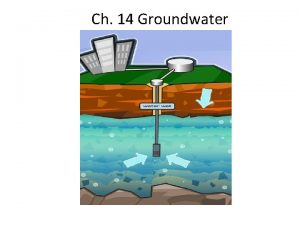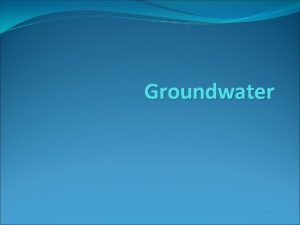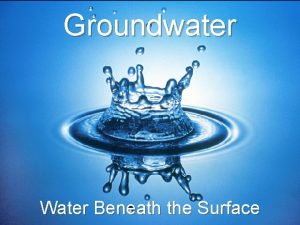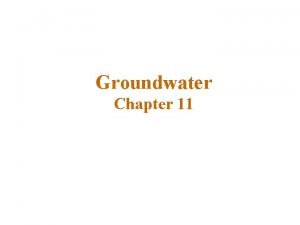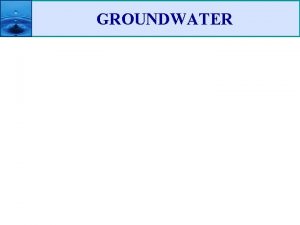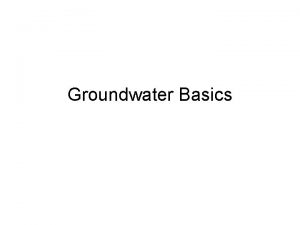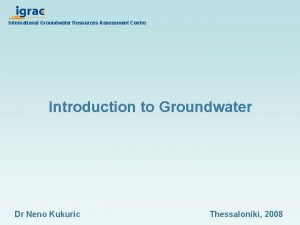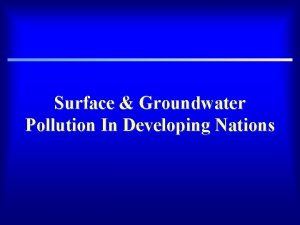Introduction Water Resources Groundwater Surface water Rain water




































- Slides: 36


Introduction Water Resources ( Groundwater, Surface water, Rain water, …) Transfer of water Water Treatment Water Distribution Water Consumption

Water Treatment Objectives Removal of : q Suspended solids q Turbidity q Color q Taste & odor q Pathogens q Other specific pollutants (nitrate, heavy metals, organics, …) In order to Meet (Local, National, regional, and International) Standards

Engineered systems for water purification Typical plant treating hard ground water : Raw water D. S Aeration Softening Storage Disinfection Sedimentation Filtration

Engineered systems for water purification Typical plant treating turbid surface water with organics Presedimentation Raw water Storage D. S Disinfection Coagulation/ Flocculation Adsorption Sedimentation Filtration

Engineered systems for water purification Coagulation/ flocculation Aim: To remove colloids from water Coagulation: chemical conditioning of colloids : flocculation : physical conditioning of colloids Main Coagulants: Aluminum sulfate : AL 2(SO 4)3 Iron salts : Fe. SO 4 PAC: Poly aluminum Chloride Floc

Engineered systems for water purification Coagulation/ flocculation Coagulation Flocculation

Sedimentation Aim: Solid- liquid separation Applications: - Plain settling of particles - Settling of flocculated particles - Settling of lime /soda softening particles - Settling of treated water from Fe/Mn removal

Engineered systems for water purification Sedimentation Types of sedimentation systems : - Circular: 4. 5 – 91 m Diameter, 3 – 4. 5 depth - Square: 10 – 60 m Diameter , 1. 6 - 6 m depth - Rectangular

Sedimentation

Sedimentation

Sedimentation Rectangular Clarifier (Outlet End)

Sedimentation Circular Clarifier (Outlet End)

Sedimentation

Sedimentation Settling types of solids : - Type 1: Low Conc. , Discrete particle - Type 2: - Type 3 : - Type 4 : High Conc. , Very flocculated

Sedimentation Type 1 settling: Discrete sedimentation fd Fb Stock’s Law Vp= g (ρp – ρw) d² /18μ Vp= Settling Velocity ρp = Solids density μ=Liquid Viscosity ρw = Liquid density d= Particle diameter 4 ﻭ 1 ﺍﻃﻼﻋﺎﺕ ﺑﻴﺸﺘﺮ ﻭ چﻨﺪ ﻣﺴﺌﻠﻪ ﺣﻞ ﺷﺪﻩ ﺩﺭ ﻣﺮﺍﺟﻊ ﺷﻤﺎﺭﻩ Fw fd

Sedimentation Design criteria: Over flow rate = Q/A = 20 -40 m³/m². d Detention time= 2 – 8 hr (4 -6 hr)

Filtration Filter types 1) Based on Driving Force 2) Based on Filtration Rate 3) Based on Flow direction 4) Based on media

Filtration 1) Based on Driving Force q Gravity filter q Pressure filter Gravity filter

Filter Types Based on Filtration rate: - Slow sand filter (rate < 10 m³/m². d ) - Rapid filter : 120 m³/m². d - High rate : 240 m³/m². d

Filter Types Based on Flow direction : - Down flow - Up flow Based on media types: - Single medium filter - Dual medium filter - Multi media filter

Filtration ( Rapid Sand Filter)

Filtration ( Rapid Sand Filter)

Filtration ( Rapid Sand Filter)

Filtration ( Rapid Sand Filter) Backwash Phase

Filtration ( Rapid Sand Filter) Filter Media Size and Uniformity of filter media: Effective size=ES= d 10 = the sieve size in mm which permit 10 percent of the medium to pass Uniformity coefficient = UC= d 60/ d 10 For Sand: ES= 0. 45 – 0. 55 mm US = 1. 2 -1. 7

Engineered systems for water purification Aeration & gas transfer Aims: 1 - To remove undesirable dissolved gases in Water 2 - To remove dissolved inorganic substance such as Fe/Mn Aeration systems: q Compressed air --- Diffuser q Mechanical aeration q Cascade aeration q Spray aerator

Engineered systems for water purification Aeration Systems- Compressed air

Engineered systems for water purification Aeration Systems Mechanical Aeration Casecade Aeration ( )ﺗﻮﻧﻞ ﻛﻮﻫﺮﻧگ

Engineered systems for water purification Softening Aim: hardness reduction to desirable value (50 -150 mg/l) Important Softening methods: q Chemical Softening q Ion Exchange

Engineered systems for water purification Softening Chemical precipitation : - Ca hardness: Calcium Carbonate ↓ - Mg hardness: Magnesium Hydroxide ↓ Ion exchange : {Ca +² / Mg +²} + 2 Na-R → {Ca / Mg }-R+ 2 Na + {Ca / mg }-R+ 2 Na Cl → { Ca / Mg} Cl 2 + 2 Na- R

Disinfection Aim: Destruction of pathogens from water Main Disinfectants used in water treatment: q Chlorine q Ozone q UV

Disinfection q Chlorine is most common disinfectant in water and wastewater treatment Disadvantages: q Chlorine is a dangerous chemical q Can form disinfection byproducts (DBPs), Trihalomethanes (THMs) which are possible carcinogens

Disinfection Technology Environmentally Byproducts Effect Investment Operational costs + + ++ - + ++ ++ + -/+ ++ -- -- - + ++ friendly Ozone UV Chlorine gas Ref: http: //www. lenntech. com/processes/disinfection/

Ozonation system in Water Treatment Plants

Disinfection By UV radiation
 True or false: groundwater can flow.
True or false: groundwater can flow. Summary of rain rain go away
Summary of rain rain go away Running water and groundwater
Running water and groundwater Water erosion and deposition
Water erosion and deposition Chapter 6 running water and groundwater
Chapter 6 running water and groundwater How does groundwater rejoin the water cycle
How does groundwater rejoin the water cycle Water and water and water water
Water and water and water water Transformed resources and transforming resources
Transformed resources and transforming resources Fixed resources
Fixed resources Renewable resources vs nonrenewable resources
Renewable resources vs nonrenewable resources Acid rain chemical reaction
Acid rain chemical reaction Ground water pollution
Ground water pollution How we can reduce water pollution
How we can reduce water pollution Njdep groundwater quality standards
Njdep groundwater quality standards Modflow analyst
Modflow analyst Groundwater assessment methodology
Groundwater assessment methodology Water table
Water table Septic tank contamination groundwater
Septic tank contamination groundwater Groundwater flow net
Groundwater flow net Brainpop carbon cycle
Brainpop carbon cycle Rajiv gandhi groundwater raipur
Rajiv gandhi groundwater raipur Total hydraulic head
Total hydraulic head Permeability in rocks
Permeability in rocks Arc hydro groundwater
Arc hydro groundwater On the surface of water
On the surface of water Groundwater table
Groundwater table Is groundwater renewable or nonrenewable
Is groundwater renewable or nonrenewable Ainkholes
Ainkholes Human impact on groundwater
Human impact on groundwater Groundwater
Groundwater Groundwater system
Groundwater system Groundwater system
Groundwater system Iöz
Iöz Groundwater
Groundwater Uses of ground water
Uses of ground water What is importance of groundwater
What is importance of groundwater Groundwater
Groundwater
